![]()
![]()
![]()
Use LEFT and RIGHT arrow keys to navigate between flashcards;
Use UP and DOWN arrow keys to flip the card;
H to show hint;
A reads text to speech;
11 Cards in this Set
- Front
- Back
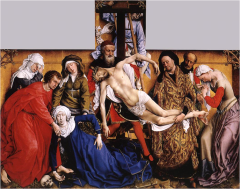
|
Rogier van der Weyden, Deposition (for the archers guild), c. 1435-38, oil on panel
The composition of Jesus' frail, curved body is mimicked by his mourning, fainted mother and is meant to evoke empathy for Christ's passion. To add to the effect the mourners are shown with details of tears and puffy eyes while St. John and Mary Magdelene serve as a parenthesis to the composition. |
|
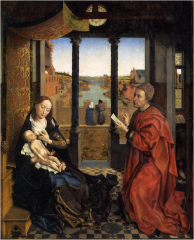
|
Rogier van der Weyden, Saint Luke Painting the Virgin, 1435-40, oil on panel
With similar composition to Van Eyck's Rolin Madonna, this piece also features vast detail in the cityscape, realistic portrayal of infants and a possible self-portrait of Van Der Weyden as St. Luke. |
|
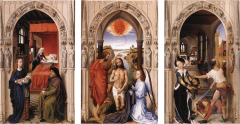
|
Rogier van der Weyden, St. John the Baptist Altarpiece,c. 1440-44. oil on panel
Devoted to St. John. His birth and naming by Zachariah, baptism of Christ with God present, and beheading with Salome’s dance in the background. |
|
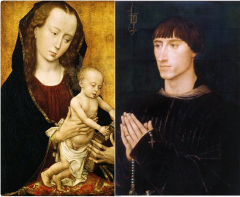
|
Rogier van der Weyden, Diptych with Virgin and Child and Philip de Croy, c. 1455-60, oil on panel
Not only is it a warm portrayal of the bond between mother and child but also indicates the patron to be a high-ranking courier with a love for books. |
|
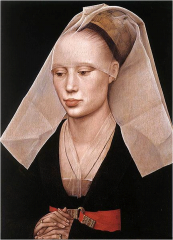
|
Rogier van der Weyden, Portrait of a Lady, c. 1460, oil on panel
This portrait of a Burgundian noblewoman shows great detail in the facial features and even the folds along her translucent veil, while at the same time creating a stable, triangular composition. |
|
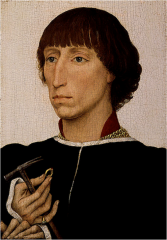
|
Rogier van der Weyden, Francesco d’Este, c. 1460, oil on panel
The ring and mallet are possible symbols of him being the winner of a joust. |
|
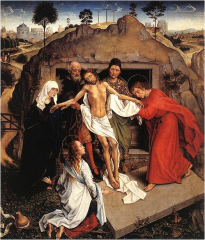
|
Rogier van der Weyden, Farewell at the Tomb, c. 1450, oil on panel
Based on Fra. Angelico's Lamentation but enhanced by the placing of mourners in a semi-circle around Christ and placing the tomb around a more elaborate landscape. |
|

|
Rogier van der Weyden, Last Judgment Altarpiece at Beaune Hospice, c. 1445-48, oil on panel
Depicts Christ in judgment with an angel weighing the souls of the dead. St. John and Mary praying for the salvation of the souls. On the right, salvation and the left, damnation, both featured with disturbingly real emotions. The altarpiece was made to hang at a hospice where one could contemplate atonement from their sickbed. |
|
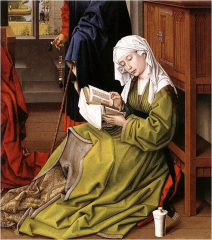
|
Rogier van der Weyden, The Magdalen Reading, before 1438, oil on panel
Joseph stands over Mary Magdalene (recognized by her ointment jar that she used to anoint Jesus’ feet) reading while wearing extravagant clothing. Great details that show opening letter of the book Mary is reading, a tiny background person, a fleur-de-lis on a background mans shoe, gold on cloth, pearls & sapphires and perfected crystal beads (excellent even when compared to Van Eyck’s beads in the Arnolfini Portrait. |
|
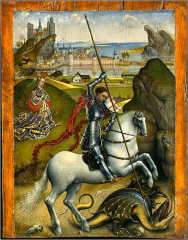
|
Rogier van der Weyden, Saint George and the Dragon, c. 1432/1435, oil on panel
The gleam of armor, gold material and dragon scales evident even in this tiny diptych. |
|

|
Rogier van der Weyden, Crucifixion, 1454-64, oil on panel
No distraction from seminal moment of Christ moment on the Cross and its effect on those close to him. Shows how Rogier can go from small, minute works to monumental without losing detail and emotion. |

